If you’re someone looking for a beautiful, fun-loving, and intelligent dog, chances are you’ve come across Bernedoodles. These pups make fantastic family pets and will surely bring you joy for years to come! They even make amazing therapy dogs.
Similar to many other Poodle mixes – such as the Goldendoodle, Australian Labradoodle, or Aussiedoodle – Bernedoodles come in many colors. Doggies that certainly stand out from the crowd are merle Bernedoodles.
Is it challenging to find a merle Bernedoodle? Are these pups expensive?
Here’s what you need to know about this beautiful color pattern.
Bernedoodle’s Coat
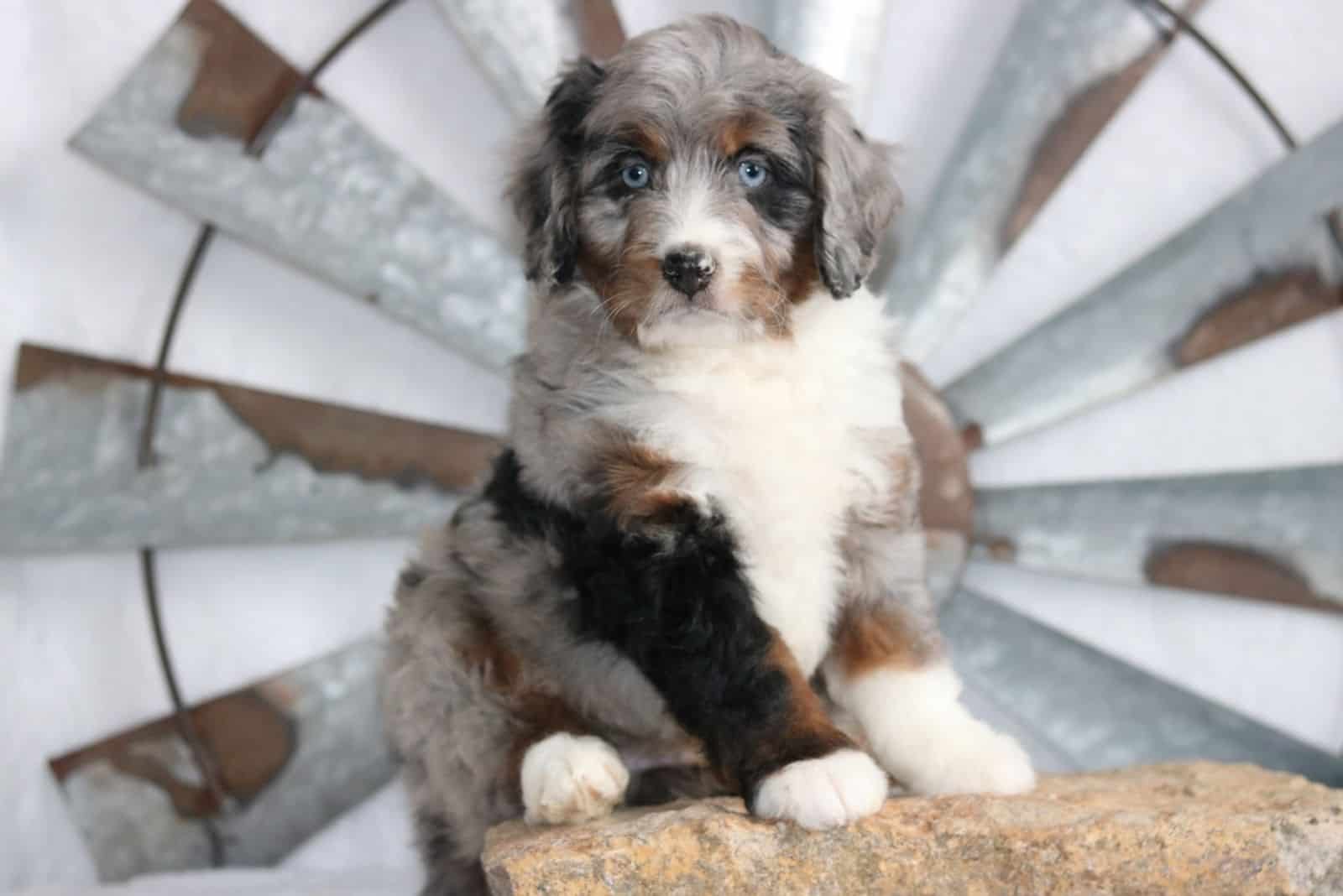
A Bernedoodle (sometimes spelled as Bernadoodle) is a crossbreed – also known as a designer or a hybrid breed – of a Poodle and a Bernese Mountain Dog. They come in various sizes, and they can look more or less like each of their purebred parents.
Because they are a relatively new breed with a wide variety of looks, most canine clubs, such as the AKC, don’t recognize them as a regular dog breed.
Depending on the color of their Poodle parent, Bernedoodles can come in several sizes. You can find standard Bernedoodles, mini Bernedoodles, even teacup Bernedoodles!
This is an issue many crossbreeds face, as their genes give them a considerable number of possibilities when it comes to size, temperament, and coat coloring.
In fact, it is this range of colors of its fur that makes Bernedoodles so interesting to many.
Bernedoodles have a few standard base colors, but they also come in variations of each.
Typically, standard Bernedoodle shades are tri-color, phantom, sable, brindle, parti, merle, bi-color. However, you can find them in merle tri-color, parti merle, sable phantom, and similar.
Other than coloring, a variety of Bernedoodle sizes also makes them so unique.
For example, you might breed a mini Bernese Mountain Dog with a Toy Poodle to get a Mini Bernedoodle! However, even this crossbreed might result in a larger dog or merely a doggie with short legs!
The same goes for the Bernedoodle’s fur. Although they are mostly curly, a Bernedoodle’s hair can sometimes lean towards being wavy, especially if your pup looks more like his Bernese parent.
This type of coat also means that most Bernedoodles are hypoallergenic.
In fact, breeding any type of dog with a Standard Poodle will commonly result in hypoallergenic puppies. This is the main reason why there are so many Poodle crossbreeds.
Merle Bernedoodles
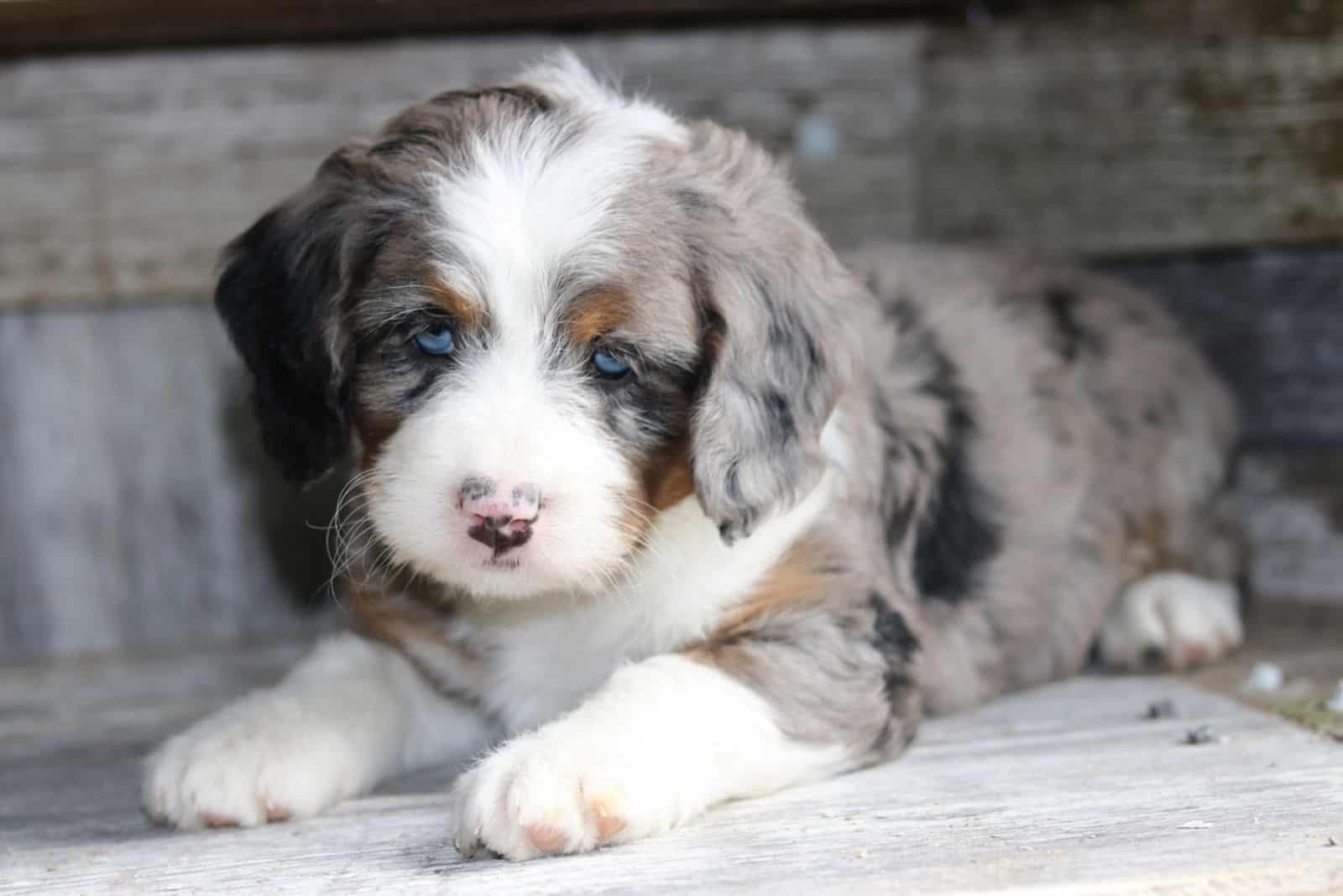
While some people wrongfully say that merle is their favorite Bernedoodle color, it is, in fact, a pattern and not a color.
Merle includes solid base color, typically black, red, or brown, with lighter patches giving it a speckled effect. These speckles aren’t even, as seen in Dalmatians, but appear mottled.
Most merle Bernedoodles have white markings around their necks, on their muzzles, and under their bellies, but this isn’t a regular part of the merle pattern.
The same goes for tan points, which are usually located between the white and dark parts of the coats.
There are many merle Bernedoodles out there without any white or tan markings. These are still considered full-merle dogs.
Also, merle Bernedoodles can come in any color, not just the usual brown, white, and black.
Merle isn’t a recognized color in neither Poodles nor Bernese Mountain Dogs, but you can find this gene in both dog breeds. This means that the gene can be inherited from both parents.
As merle Bernedoodles are quite rare and challenging to breed, many people would be shocked at their high pricing. These pups can cost over $4,000!
The Merle Gene
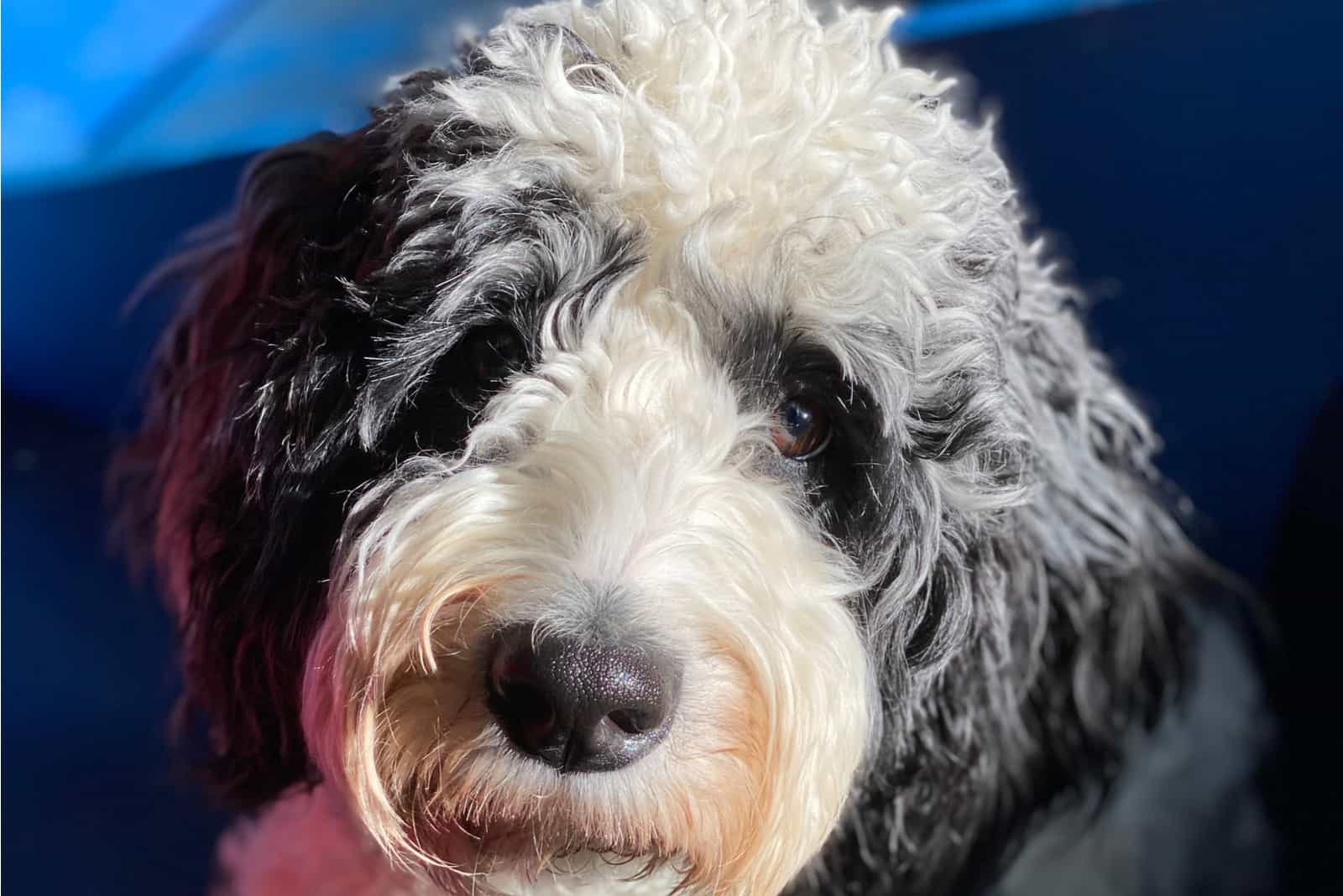
Merle is known as a dilution gene.
In other words, it lightens the existing coat color of a dog, such as a Bernedoodle.
This lightening effect doesn’t spread equally over the fur. Instead, it leaves patches of pure color scattered around, giving your pooch that spotted look. The merle pattern is most easily noticed against a black color.
But where does this gene come from? The answer to this is still a mystery.
Merle is still a highly debatable topic when it comes to Poodle genetics. It is likely a recessive gene, as it won’t show up over dominant colors, such as apricot and red. In fact, it’s seldom visible on blue and silver pups either!
What makes everything even more confusing is that not all brown or black coats will exhibit a merle pattern, despite carrying this gene. On these occasions, we’re talking about a cryptic merle, a dog whose merle genetics have been hidden.
Merle can be challenging to see in Bernedoodle puppies. Because of this, it isn’t rare that even breeders aren’t aware of having a merle dog.
While there have been numerous studies on the merle gene, some of the biggest news came in 2006, when it was noticed that the merle pattern was caused by a unique mutation in the SILV and the PMEL17 gene.
This resulted in a significant breakthrough, as a test for identifying the merle gene was finally made. This allowed breeders to determine whether they had a merle-colored puppy or not.
Or so they thought.
In 2009, Idexx, the company that had the patent for this gene test, stopped selling them as it determined it was giving false results. It turned out that a mutated SILV gene didn’t cause merle.
The SILV gene mutation does cause a particular pattern, but it wasn’t merle. Instead, it was a form of piebaldism.
This caused some researchers to believe that the piebald pattern is somehow connected to merle. They went so far as to suggest that merle is a type of piebaldism!
Other scientists, however, believe that the merle pattern has been misidentified. They claim that merles are a standard Poodle color and that the gene has always been in the breed.
It simply wasn’t recognized beforehand, as people confused it with silver or other genes.
This can be somewhat confirmed if you look at the color codes that the AKC listed as breed standards.
Some of the codes they have are 002 and 146, which refer to a white and red canine with black markings. This could be the result of an unidentified merle gene.
The final theory is the cryptic merle gene theory, which is quite similar to the previous one.
Merle is a dilution gene. It won’t give your pup a new color but rather dilute an existing one. This could mean that many known colors are the results of a merle gene.
For example, a blue merle is a merle gene that acted on a black coat, and red merle is on a chocolate or brown coat. The list can go on.
Breeding Merle Bernedoodle Puppies
Breeding merle Bernedoodles can be quite tricky. This is because the merle gene can cause some health issues – but more on that later.
The merle gene is a recessive gene, meaning it can go unnoticed in many dogs. Also, if combined with any dominant gene, the merle pattern won’t be visible.
It might be easy to think that you can breed two merle Bernedoodles and get a perfect merle puppy, but this isn’t a good idea. If anything else, two merle genes usually make a pure white color and not a standard merle pattern.
Instead, only one parent can be a carrier of this dilution gene. Usually, this means that only half of the puppies from the litter will be merle.
Some breeders prefer having first-generation (F1) merle Bernedoodles. In other words, they’ll crossbreed a purebred Bernese Mountain Dog with a purebred Poodle. One of the parents will have to have the merle gene.
Breeding F1 merle Bernedoodles is the healthiest option – although there usually won’t be issues with pups of one merle parent.
Some breeders will mix an Australian Shepherd with a Bernedoodle to ensure the pup has the merle gene.
In fact, what some breeders call merle Bernedoodles are actually Aussiedoodle puppies. As these two dog breeds are quite similar, it’s easy to confuse the two. You may even mistake a mini Aussiedoodle with a tiny Bernedoodle!
If you want to make sure your new puppy is indeed a merle Bernedoodle, always ask to see the parents.
Health Concerns
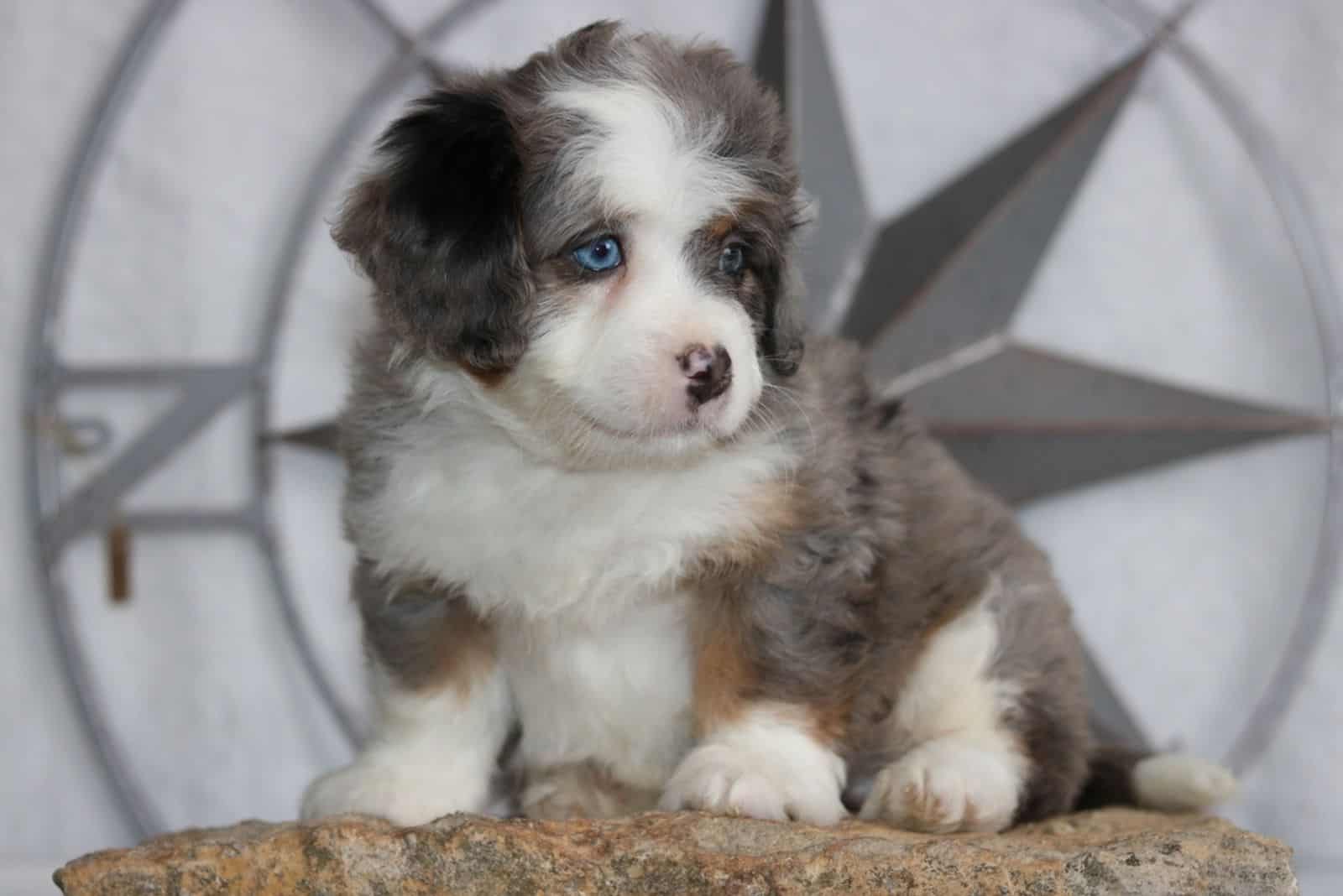
Merle genes won’t affect only the coat color. Plainly speaking, they’ll ‘dilute’ many other things inside a pup’s body, including its eyes, ears, bones, and heart.
Dogs that carry two copies of the merle gene – or rather, dogs that are ‘double merle’ – have a very high chance of having vision and hearing problems. They will commonly be entirely deaf and blind.
This is because the merle gene suppresses pigment cells in the iris and the inner ear. While this results in a beautiful blue eye color, it also leads to sensory losses.
Not just that, but the merle gene can weaken the bones and heart of a Bernedoodle, causing life-threatening conditions.
If you find out your merle Bernedoodle is blind or deaf, don’t worry. These dogs can still have a quality life if you take good care of them.
However, while not strictly forbidden, intentional breeding of dogs that have a higher chance of developing defects is certainly unethical.
Common Merle Bernadoodle Patterns

Photo from:@baileythebernadoodle
Despite the health concerns associated with merle patterns, this is still one of the most popular patterns in Bernedoodles.
While most noticeable on black, merle can affect any coat color.
If it affects a brown coat, you might mistakenly call this Bernedoodle red – although this isn’t correct, as red has its own genetics. Similarly, if it affects the black coat, it will look just like blue or silver.
In fact, merle is somewhat similar to the blue or light chocolate color since all three are the results of the dilution of a primary color. However, merle has its own colors, as well as DNA.
For example, you may have a blue merle – a Bernedoodle with blue patches all over its body. ‘Cookies and cream’ are chocolate pups with a merle gene, as they have patterns resembling these sweet treats.
Recessive red Bernedoodles can still have a merle gene, although the pattern will hardly be noticeable. In fact, if a dog is plain red, chances are you won’t notice merle at all.
Combinations with several patterns are rare, so you won’t commonly see a brindle merle Bernedoodle, but they exist as well.
Overall, the most common merle pattern in Bernadoodles is blue with chocolate and red spots.
The merle gene affects more than just a dog’s fur. It will modify a Bernadoodle’s eye color, as well as the coloring on its nose and paw pads.
Because of this, merle Bernadoodles seldom have dark eyes. Instead, their eyes are usually blue. Heterochromia is also quite common, so you might have a dog whose eyes are different colors or a pup with only part of its eye colored blue. Every combination is possible!
The paw pads and nose will also often be in two colors, and they’ll typically be black with pinkish spots. This makes these dogs quite unique, as no two pups are alike!
Should You Get a Merle Bernedoodle?
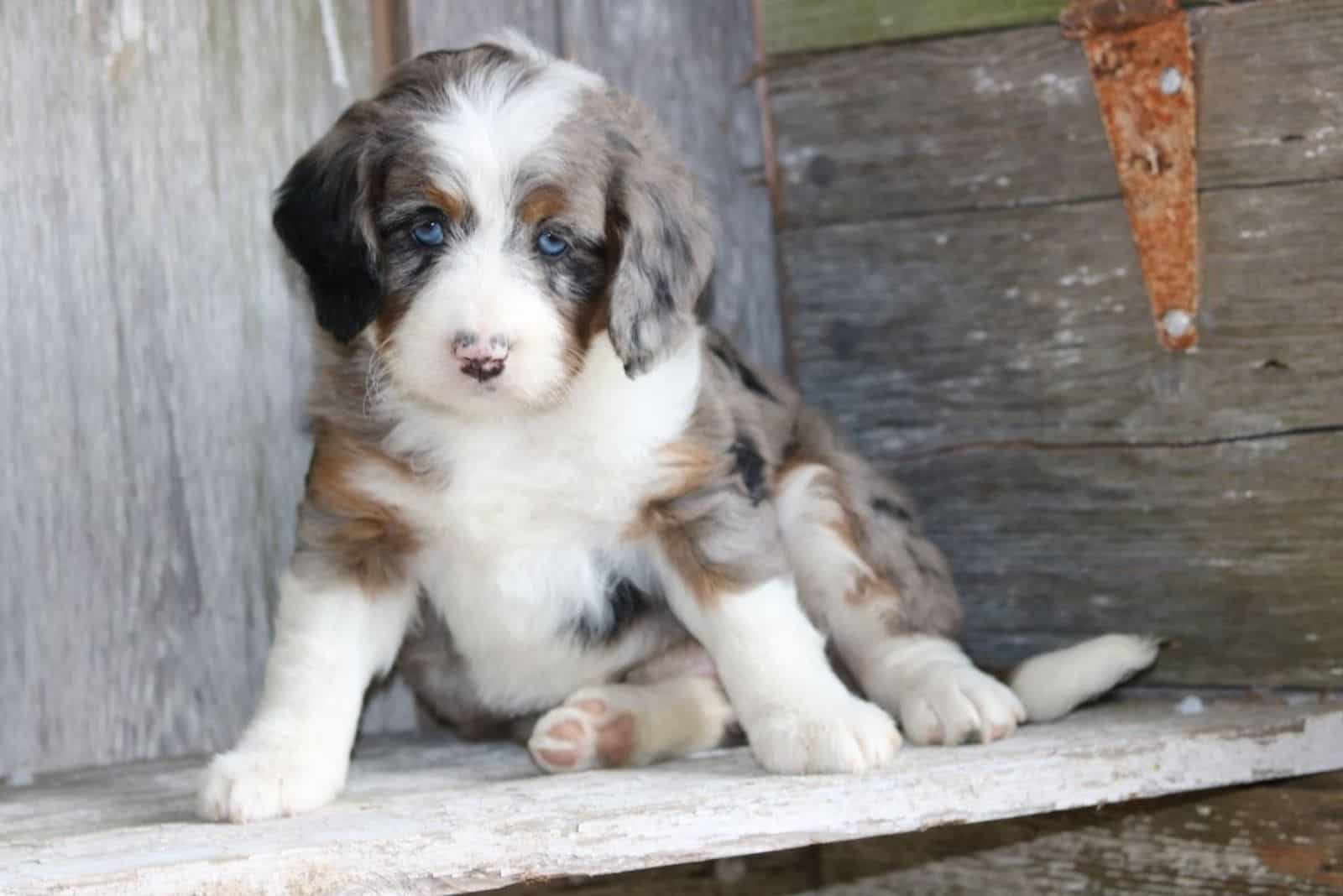
As you can see, merle Bernedoodles are quite rare. Suppose you want to have a dog that is good-looking, well-mannered, and intelligent. In that case, you should definitely consider getting one!
However, many people worry because of all the health issues associated with this pattern. Some are even entirely against breeding merle puppies, as there are discussions about whether the merle gene should be spread around.
Still, merle Bernedoodles will exist, whether bred intentionally or not. A recessive gene can remain hidden for generations before finally exhibiting itself in a certain generation.
If you get a merle Bernedoodle but fear it might have vision or hearing impairment, don’t panic. Even entirely blind and deaf dogs can be wonderful pets.
We’d recommend any merle Bernedoodle owner who fears their pooch might have some health complications to visit their local vet. If you take good care of your merle pup, you can expect it to live a long, happy life.
Of course, not all merle dogs have health complications. In fact, most don’t have any consequences except for their cute color pattern. Despite this, you have to be aware of all the possibilities.
So, whether you should get a merle Bernedoodle or not is entirely up to you. All Bernedoodles, just like both of their parent breeds, make wonderful family pets, (no matter if they’re male or female, merle or any other color) and you certainly won’t be making a mistake if you do get one.


